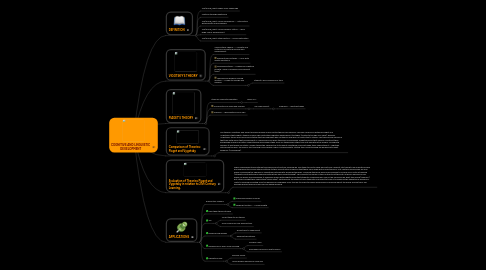COGNITIVE AND LINGUISTIC DEVELOPMENT
por Kristian Zambrana


1. PIAGET'S THEORY
1.1. Stage of Concrete Operation
1.1.1. Age 6 or 7
1.2. Conservation of liquid and number
1.2.1. No achievement
1.2.1.1. Problems--->Abstract ideas
1.3. Children--->Recognition one's own
2. Comparison of Theories: Piaget and Vygotsky
2.1. The theories Vygotsky and Piaget are well renown and accepted theories of learning. The main difference between Piaget and Vygotsky is that Piaget's theory is more rigid restricting cognitive development to stages (related to the age of a child), whereas Vygotsky's theory was more open stating that development was continuous and was not restricted to stages. The theories are similiar in that they both agree that development or learning occurs when the brain is challenged. Piaget believed that children construct their knowledge and have a better understanding of problems they solve for themselves rather than just being told the answer. Duckworth explains it best when she states "simply telling the children the truth about something could not make them understand it". Vygotsky introduced the ZPD, the idea of that learning occurs when a child is challenged to stretch their understanding by working with adult guidance (Scaffolding).
3. Evaluation of Theories Piaget and Vygotsky in relation to 21st Century Learning.
3.1. When considering these veteran theories and 21st century learning we find them to be still valid, and not only valid but still trying to be understood fully and implemented in educational settings to their full potential. Evidence that these ideas align with current goals of 21st century learning can be seen when considering the changes in legislation pertaining to learning standards. Learning standards have been changed to include more critical thinking (students constructing and communicating their own understanding). This reflects the ideals of the constructivist theorists at hand: learning occurs when our brains are challenged, it especially aligns with Piagets belief that students comprehension can not be measured by what they know (memory) but rather by what they understand (application). Furthermore the ideas of these theorists is relevant to today's teaching as the educational delivery or route to learning is shifting from the passing of knowledge from teacher to pupils to pupils discovering or inquiring about the world around them. For example project approach and service based learning.
4. VIGOTSKY'S THEORY
4.1. Sociocultural Theory---> Society and culture in promoting learning and development
4.2. Different kind of tasks--->only with adults assistance
4.3. Challenging tasks--->Maximum cognitive growth : Zone of Proximal Development (ZPD)
4.4. Learning and problem solving abilities---> begin to emerge and develop
4.4.1. Student's ZPD change over time
5. APPLICATIONS
5.1. Elementary schools
5.1.1. Challenge children's minds
5.1.2. Pushing it further---> Brain growth
5.2. Help them think critically
5.3. Try:
5.3.1. To get them to see things
5.3.2. from someone's else perspectives
5.4. Develop new lessons
5.4.1. Allow them to experiment
5.4.2. different hypothesis
5.5. Building off of prior social learning
5.5.1. Children learn
5.5.2. new ideas from peers and teachers
5.6. Educator's goal
5.6.1. Enforce norms
5.6.2. Guide proper learning of social life
